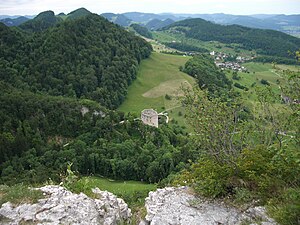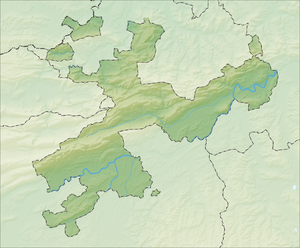Gilgenberg ruins
| Gilgenberg | ||
|---|---|---|
|
View from Portiflue to the Gilgenberg castle ruins, Meltingen in the background |
||
| Creation time : | around 1300 | |
| Castle type : | Höhenburg, spur location | |
| Conservation status: | ruin | |
| Place: | Zullwil | |
| Geographical location | 47 ° 23 '1 " N , 7 ° 36' 27" E | |
| Height: | 710 m above sea level M. | |
|
|
||
The Gilgenberg ruins are the ruins of a hilltop castle in the area of the municipality of Zullwil in the canton of Solothurn . It stands at 710 m above sea level. M. on a rock spur in a wooded valley basin southeast of the village of Zullwil and can be easily reached from the village on a marked hiking trail in around 10 minutes.
investment
The ruin consists essentially of a powerful five-story, long-drawn-fortified palace with almost hexagonal floor plan. Its extension is about 30 by 10 meters. Access was via a ridge from the southwest via a covered bridge that led over an artificially created neck ditch . The bridge led to a small kennel in front of the actual castle gate. Beyond the drawbridge there were several utility buildings, some of which are still preserved.
history
Gilgenberg Castle was built around 1300 by the Lords of Brislach as part of the expansion of their clearing activities over an older facility from around 1200. They called themselves "von Ramstein" after their ancestral seat above Ramstein above the village of Bretzwil . The name Gilgenberg refers to the Ramsteiner coat of arms, documented from 1265, which shows two crossed lily wands (Gilgen). The Lords of Ramstein were vassals and ministerials of the Bishop of Basel . In the feud between the bishop and Rudolf von Habsburg , the Ramsteiners sided with the Habsburgs in the late 13th century.
After the capture of a Basel citizen by the Ramsteiners, the Ramstein family castle, built around 1150, was destroyed by Basel in 1303. Gilgenberg was not built as a replacement, but as the administrative center of the Ramsteiners' land holdings in this area, which were expanded through clearing and acquisitions.
The castle was first mentioned in a document in 1312: Thuringia von Ramstein describes itself as Herre ze Gilienberg . Gilgenberg was also affected by the Basel earthquake of 1356, but it is not documented how severe it is. Although originally an allodial rule , the Gilgenberg was transferred to an episcopal fief in order to protect itself against foreign attacks. A fiefdom from 1371 provides information about Gilgenberg's rulership rights, which included the manorial power in Meltingen , Zullwil and Nunningen , in the mill in the Engi and in the farms of Roderis and Fehren . There were also other goods and rights.
In 1371, Rutschmann von Ramstein received the episcopal fief, whereby the Gilgemberg Castle with the tower uff dem velden in front of it is mentioned. This tower stood on a rock spur 180 meters south of Gilgenberg. The place is still recognizable today by the artificially flattened rock. After 1400 the tower is no longer mentioned.
Until 1459 Gilgenberg belonged to the Ramsteiners as an episcopal fief. The complex consisted mainly of a mighty residential tower with several outbuildings. A bailiff lived in the castle; the Ramsbergers lived in Basel , where they held various offices or in the moated castle of Zwingen . The generously laid out castle on islands in the Birs was intended as the center of a city to be founded, but it was never built. The coat of arms of the community of Zwingen still shows the crossed lilies of the Ramsbergers.
Rudolf von Ramstein and son
However, the court in Rottweil rejected all claims and so Gilgenberg remained in the possession of Rudolf's illegitimate son Hans Bernhard von Gilgenberg . Rudolf von Ramstein, the last offspring of the barons, was married to Ursula von Geroldseck . After ten years, Ursula left her husband because of marital infidelity and moved to live with her sister in Sarrewerden . The eldest of her three daughters married Thomas von Falkenstein, the two younger ones allowed themselves to be kidnapped by farm boys, as no suitable suitors could be found. However, they were captured and brought back. The kidnappers were beheaded and the father put the younger one in the stone monastery in Basel. Nothing is known about the fate of the older daughter. Rudolf continued to live with his concubine at Zwingen Castle . It is not known who she was. In 1459, Rudolf von Ramstein's death triggered a lengthy dispute over inheritance. Rudolf's legitimate wife Ursula made claims, as did Thomas von Falkenstein. He placed her under the protection of the city of Solothurn , moved into foreign service and left his wife Suslin with her two sons at the castle. Hans Bernhard von Gilgenberg fell in the service of Charles the Bold in 1474 during the siege of Neuss on the Rhine, his fiefdom went to his son Hans Imer von Gilgenberg . Junker and knight Hans Imer first devoted himself to the craft of war and became Austrian and royal steward in Ensisheim . He was later a council member in Basel and was mayor there from 1496–99.
Solothurn
Gilgenberg was occupied by Solothurn troops in both the Burgundian and Swabian Wars . Attempts to buy Solothurn, Burg and Herrschaft Gilgenberg initially failed because the people of Basel resisted, claiming their jurisdiction as owners of the Landgraviate in Sisgau . As a result, there was a bloodless gallows war between the cities served , which a federal arbitration court ruled in favor of Solothurn in 1531.
In 1527 Hans Imer sold Gilgenberg with the villages of Nunningen, Meltingen and Zullwil with high and low dishes for 5900 guilders to the city of Solothurn. In 1580 the Bishop of Basel officially renounced his rights. Solothurn set up a bailiwick on Gilgenberg, which was also known as the "goat bailiwick" because of its limited income.
After Hans Imer's death in 1533, his son-in-law Paul von Rinach received the Gilgenberg fiefdom, which had since been converted into Gülte .
In 1576 the Council of Solothurn sent a delegation to the Vogtei, after which the castle was restored by Hans Schmid. In 1678 the windows of the apartment were enlarged on the south side. Another repair and redesign of the interior took place in 1734. In 1734 the chapel received a new small bell tower.
destruction
In the turmoil of the Helvetic Revolution of 1798, Gilgenberg Castle was destroyed: angry rural residents set the castle on fire and used the ruins as a quarry. In 1930 the masonry was preserved for the first time. In 1941 the ruin became the property of the “Gilgenberg Castle Foundation”. In 1982 the masonry of the palace was secured for the last time.
literature
- Werner Meyer : Castles from A to Z - Burgenlexikon der Regio . Published by the Castle Friends of both Basels on the occasion of their 50th anniversary. Klingental printing works, Basel 1981, pp. 202–204.
- Gottlieb Loertscher: The districts of Thal, Thierstein and Dorneck . In: The art monuments of the Canton of Solothurn . Birkhäuser, Basel 1957, Volume 3, pp. 235–237.
- Bruno Amiet : The castles and palaces of the canton of Solothurn [The castles and palaces of Switzerland, Vol. III]. Basel 1930.
- Emil Erdin: Castles of Switzerland, Volume 7 . Silva-Verlag, Zurich 1981.
Individual evidence
- ↑ History Zwingen ( Memento of the original from August 31, 2011 in the Internet Archive ) Info: The archive link was inserted automatically and has not yet been checked. Please check the original and archive link according to the instructions and then remove this notice.
- ↑ Stone monastery
- ↑ Ancestral information ( Memento of the original from May 9, 2008 in the Internet Archive ) Info: The archive link was inserted automatically and has not yet been checked. Please check the original and archive link according to the instructions and then remove this notice.
Web links
- Castle world: Gilgenberg Castle
- Othmar Noser: Gilgenberg. In: Historical Lexicon of Switzerland .











